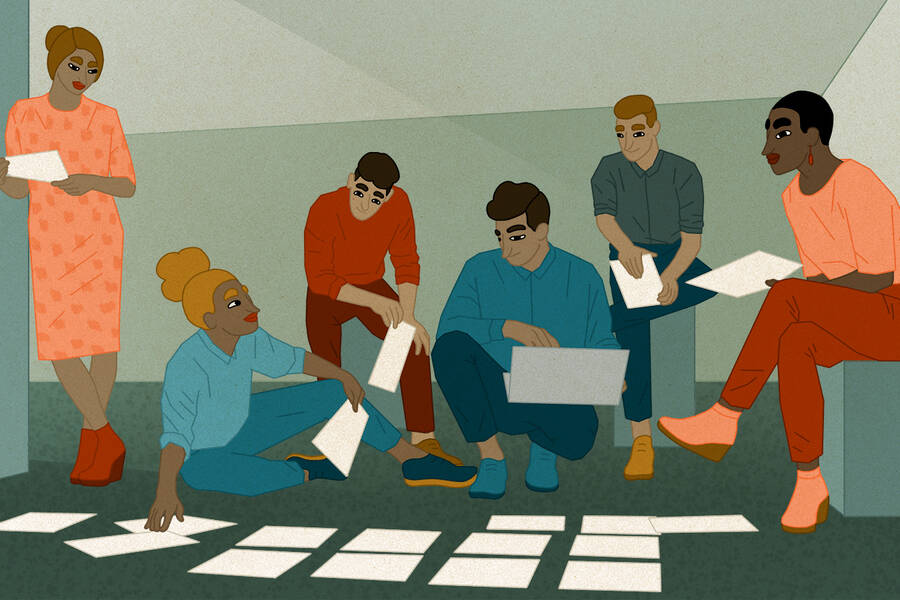Design thinking has become tremendously popular. Businesses in every industry talk about ideating and iterating, a linguistic nod to the creative process made famous by design and consulting firm IDEO.
The design-thinking approach loosely follows a four-step process that involves observing a problem, reframing it, designing solutions, and testing them—all with the end goal of improving how humans experience a product or service.
But being familiar with this process and actually putting it into practice are very different things. “Sometimes people think they’re doing design thinking, but it’s really not,” says Leigh Thompson, a professor of management and organizations at Kellogg. “When you get it right, it’s really powerful.”
Rather than blindly following the approach, she says, it can be helpful to understand the psychology behind it. And critically, social psychology also offers insight into specific ways to get more out of each step in the process.
“The science is what explains the magic,” says David Schonthal, a clinical professor of strategy at Kellogg and director of the Levy Institute for Entrepreneurial Practice. He and Thompson recently published a paper on this topic and teach a course together on using creativity as a business tool.
So why does design thinking work? And how can businesses effectively apply these principles themselves? Thompson and Schonthal explain.
1. Look for the gorilla.
The first step in the design-thinking process is to observe a situation and notice what is actually happening. This sounds straightforward. But Thompson points out that we are actually really bad at observing a situation and noticing what is actually happening—despite having a lot of confidence in our own abilities.
Twenty years ago, researchers Christopher Chabris and Daniel Simons conducted a now-famous experiment in psychology. They showed participants a video of people playing basketball and instructed them to count how many times the players on a particular team passed the ball.
About 45 seconds into the video, a woman wearing a full-body gorilla costume walked across the screen. But a large number of participants didn’t notice this oddity at all. They were too focused on counting passes—an illustration of a phenomenon psychologists call inattentional blindness.
“Sometimes people think they’re doing design thinking, but it’s really not.”
— Leigh Thompson
“People are very limited in what they’re able to perceive in their visual world when they’re focused on one thing,” Thompson explains. “Coupled with the fact that people believe themselves to be in the 99th percentile with regard to their perceptive abilities, that’s a dangerous combination.”
So how can we get better at noticing things?
As Thompson and Schonthal explain it, noticing is a cognitive strategy that can be broken down into three parts. First, observers must identify and abandon their cognitive scripts—the preexisting narratives that guide their understanding of situations. Next, they must learn inductively, making inferences based on limited information. And finally, they must find patterns in complex stimuli.
This is why design thinkers must get out from behind their desks and observe a problem “in the wild,” as Schonthal puts it. Relying on people to self-report their habits is not enough.
He points to an example of when a pharmaceutical company tasked IDEO with investigating its hypothesis that the packaging of its arthritis medication was too difficult for patients to open.
So the IDEO design team interviewed and—crucially—also observed patients who used the medication going about their daily routine. One elderly woman with arthritis said she had no trouble opening the packaging. But when the IDEO team asked her to actually show them how she did it, she took her pill bottle out of a drawer and put it on a meat slicer, then used the meat slicer to cut open the top of the container, because twisting the cap off herself was too painful.
“One of the biggest takeaways from this example is to never take what people say they do at face value,” Schonthal says. “Actually seeing with your own eyes what is going on can immediately spark identification of unmet needs or better ways of solving a problem.”
2. Ask a question no one else is asking.
The second step in design thinking is framing and reframing. In this step, design thinkers look at a problem from multiple vantage points, trying on different lenses to determine the best approach to finding a solution.
To better understand the importance of this process, Thompson and Schonthal highlight the work of economist Daniel Kahneman, who won the Nobel Prize for his research on cognitive framing. Kahneman showed that people make very different decisions depending on how those decisions are framed: specifically, whether they are focused on the possibility of gaining something—what design thinkers call a “promotion frame”—or by the possibility of not losing something—a “prevention frame.”
Understanding a customer’s motivations for using a product or service are important for developing something that works for the customer. Take, for example, a project IDEO conducted on diabetes management for a healthcare company. IDEO’s team found that more traditional goals like losing weight and controlling blood sugar in order to avoid health problems (which activate a prevention frame) weren’t successful in actually motivating patients to make healthy changes. But setting social and emotional goals—like gaining the ability to walk a 5K or dance with your daughter at her wedding—activated a promotion mindset and actually motivated people to change.
“Prototypes are embodied questions. It’s not building something that you hope people will fall in love with as the final product.”
— David Schonthal
Armed with this knowledge and new frame, IDEO was able to help the company move beyond creating a new medical device. Rather, IDEO helped them build a customizable app that instead solved for a different challenge: How do we help people with diabetes live their best lives?
“With any really well-thought-out product, chances are the designers started by asking a different question or solving a different problem than all of their competitors,” Schonthal says.
3. Approach brainstorming with rigor.
The third step is to imagine and design—what Thompson and Schonthal describe as “the heart and soul” of the design-thinking process. Which is why, even more than the other steps, it’s crucial to understand the science behind successful ideation.
At its core, brainstorming is about focusing on quantity over quality, building on one another’s ideas, and encouraging the most outlandish suggestions, all while avoiding criticism. And studies show that these principles, devised in the 1950s, remain effective today.
Yet people regularly violate those rules, other studies show. They suggest too few ideas or criticize individuals rather than ideas. And criticizing the person who comes up with an idea can hurt further ideation.
Thankfully, science also suggests some best practices.
First, consider a smaller ideation group. As the number of people on a team increases, the productivity of ideas per person decreases. That’s because when people work in groups—like the traditional brainstorming session—they’re often inhibited by social demands like being polite and waiting their turn.
Or consider using the brainwriting technique. In a brainwriting session, participants spend a set amount of time writing down as many ideas as they can, before a facilitator collects them all. This allows individuals to generate lots of ideas freely and without concern for criticism. One widely cited meta-analysis shows that brainwriting groups generated about two and a half times the volume of ideas generated by brainstorming groups—and a significantly greater percentage of their ideas were judged to be of higher quality.
“Most people don’t want to believe that group brainstorming is inferior to individual ideation, at least for a finite amount of time, because we feel good in groups. Groups are stimulating. They make us feel all warm and fuzzy,” Thompson explains. “But it isn’t necessarily the best way to have a creativity and innovation meeting.”
4. Fail faster. Learn sooner.
When it comes to actually building and testing solutions—the final step in design thinking—a successful designer must understand that failure is simply an expected part of the process and will ultimately make the work better.
“The idea is to fail faster and learn sooner,” Thompson says.
One key to this is ensuring that your group has a growth mindset. The term refers to the belief that ability and skill come through practice, not through innate talent. With this frame, failure becomes a way to learn, not proof of incompetency. For example, one study showed that participants who were prompted to have a growth mindset accomplished a complex task better and more enjoyably than participants who were prompted to have a “fixed” mindset.
One way to foster a growth mindset, Thompson and Schonthal explain, is to use “How Might We” (HMW) questions that get design thinkers to push past constraints. “Groups that adopt a HMW focus are more likely to persist and be creative than those who don’t think about possibilities,” they write.
Another way to reinforce the idea that you are simply experimenting—and thus that you are open to honest feedback—is to use low-fidelity materials to create prototypes.
For example, to test different ways to redesign the long-haul flight experience, IDEO used materials found around the office. For one concept, the designers literally stacked office chairs to test the idea of “bunkbeds” on a plane. Airline executives who tried to lie in the chairs quickly rejected the concept—and IDEO moved on to the next idea.
“Prototypes are embodied questions,” Schonthal says. “It’s not building something that you hope people will fall in love with as the final product.”
At the end of the process, designers ultimately want to create something that people do fall in love with. A successful final product often seems intuitive—as if the idea sprang fully formed from the designer’s brain. But as Schonthal and Thompson’s research shows, a science-backed approach is critical to innovation.
“Once you see a beautiful design, it seems obvious,” Thompson says. “But it’s really, really hard to figure out, ‘Now how does this get created to begin with?’”
Featured Faculty
J. Jay Gerber Professor of Dispute Resolution & Organizations; Professor of Management & Organizations; Director of Kellogg Team and Group Research Center; Professor of Psychology, Weinberg College of Arts & Sciences (Courtesy)
Clinical Professor of Strategy; Director of Entrepreneurship Programs at Kellogg; Faculty Director of the Zell Fellows Program; Director of the Levy Institute for Entrepreneurial Practice
About the Writer
Jennifer Fisher is a freelance writer based in Chicago.
About the Research
Thompson, Leigh, and David Schonthal. 2020. “The Social Psychology of Design Thinking.” California Management Review. 62(2): 84–99.
Read the original






